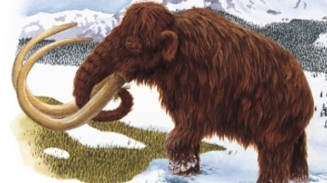
长毛象遗体揭示最早的人类北极圈活动
Mammoth Find Moves Humans in Arctic Back 10,000 Years
长毛象遗体揭示最早的人类北极圈活动
The remains of a clearly butchered wooly mammoth in Siberia date to 45,000 years ago, 10 millennia earlier than when humans were thought to have crossed north of the Arctic circle
一具长毛象遗体在西伯利亚被发现,这头明显是被屠杀的长毛象可以追溯到4,5000年前,比已知的人类在北极圈以北活动的时间早了一万年。
撰文/播音 史蒂夫·米尔斯基
翻译 Meatle
审核 乔虹
The word Siberia is almost a synonym for extreme cold. It’s hard enough to imagine living there today, but humans have been wandering the icy terrain for thousands of years. The accepted estimate for the arrival of the first humans north of the Arctic circle was upped in 2004 from about 12,000 years ago to 35,000 years ago. And now that number’s been revised again. Because in 2012 a young boy some 1,250 miles south of the North Pole in Siberia stumbled across the leg bones of a wooly mammoth protruding out of the ground.
西伯利亚,几乎就是极度寒冷的同义词。就连今天也难以想象在那个地方生活,然而人类已经在那片冰冷的土地上生存了数千年。2004年提出的一种推测曾被广泛认可,认为人类在12,000年到4,5000年前抵达北极圈以北的地区。而现在这个数字被再次修正。因为在2012年,一个居住在北极圈以南大概1,250英里的西伯利亚地区的小男孩机缘巧合下被一根左腿骨绊倒,从而发现了一具浅埋于土地中的长毛象遗骸。
“What really made this a super-important find were two things.”
“这项发现相当重要,原因有两个。”
Ann Gibbons, contributing correspondent for the journal Science, which published an analysis of the frozen mammoth, talking about the finding on the Science podcast.
安·吉本斯,《科学》杂志的特约记者。她发表了一项关于上述的冰封长毛象的分析报告,并在科学播客(Science podcast)上讲述该研究的发现。
"One, it had a lot of injuries that showed it had been battered and shot with projectile points by humans…and then the second part that was really exciting was that when they used radiocarbon dating…it dated to about 45,000 years of age. So this was at least 10,000 years older than the earliest presence of humans in the Arctic circle before." [Vladimir V. Pitulko et al, Early human presence in the Arctic: Evidence from 45,000-year-old mammoth remains]
“一是,该具遗体上有大量由人类的打击与射击所造成的伤痕;第二点,发生在他们进行碳同位素年龄测定时,测定结果表明该遗体属于大约45,000年前。因此,这具遗体至少比此前发现的人类最早在北极圈中活动的证据早了10,000年。”
People may have gone so far north because of the mammoths.
人们可能为了长毛象而踏入北极圈。
"This was a huge, vast steppe region full of mammoths and large wooly rhinoceroses and reindeer and elk…so if humans could figure out how to live in the cold up north they were lucky and would have a great source, a great packet of meat to get when they needed it.”
“这里过去是一个巨大、广阔的干草原区域,居住着大量长毛象、大型长毛犀牛、驯鹿与麋鹿。因此,若人类能找到在这寒冷的北境生存的方法,他们就是幸运的,因为当需要的时候,就能获取大量的资源,大量的肉食。”
You can hear the entire episode of the Science podcast with Ann Gibbons talking about the mammoth find at.
你能收听到安·吉本斯关于长毛象发现的完整录音。
未经书面许可任何人不得复制或镜像
京ICP备11000850号-1
 京公网安备11010502039775号
京公网安备11010502039775号 信息网络传播视听节目许可证0111611号
国家科技基础条件平台

















